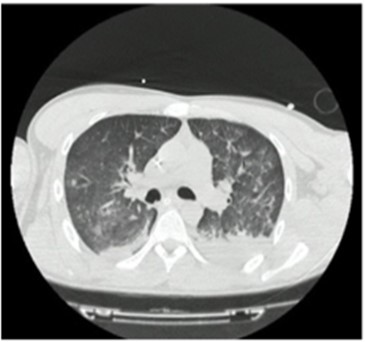Abstract
Introduction: Urinary tract infection is one of the most frequent infectious diseases in the pediatric population. There is no updated data available in literature of the pathogens responsible for complicated and uncomplicated UTI in children and their antimicrobial resistance profiles at the San Ignacio University Hospital or in the city of Bogotá.
Objective: Carry out a demographic and clinical characterization of pediatric patients with UTI and a microbiological characterization of the resistance pattern of its main etiological agents.
Study design: Cross-sectional study including all pediatric patients under 10 years of age with UTI confirmed by urine culture who consulted our institution between January 2014 and December 2017. Redcap was used for the registration of data corresponding to demographic variables, clinical manifestations, isolated microorganisms with their antibiograms, complications, and recurrence rate of UTI.
Results: A registry of 675 patients under 10 years of age with urinary tract infection was obtained, with an average age of 23 months and a higher prevalence in females (71%). 15.4% of the patients had an urinary tract malformation, 3.5% had history of previous urological surgery and 21% had constipation as a comorbidity. 98.4% of the UTIs were acquired in the community and the most common isolated agents were Escherichia coli (73.9%), Proteus mirabilis (12.4%) and Klebsiella pneumoniae (4.7%). The most frequent resistance patterns were penicillinase-producing (41.5%) multi-sensitive (32.1%) and cephalosporins resistance (26%). Regarding the treatment established, cephalosporins were used in 92% of the cases; mainly of first generation (61%) and third generation (38%). 23% of the patients had an associated complication.
Alkhateeb NE, Al Azzawi S, Al Tawil NG. Association between UTI and urinary tract abnormalities: a case-control study in Erbil City/Iraq. J Pediatr Urol. 2014;10(6):1165–9. https://doi.org/10.1016/j.jpurol.2014.05.006
Lutter SA, Currie ML, Mitz LB, Greenbaum LA. Antibiotic resistance patterns in children hospitalized for urinary tract infections. Arch Pediatr Adolesc Med. 2005;159(10):924–8.
Korbel L, Howell M, Spencer JD. The clinical diagnosis and management of urinary tract infections in children and adolescents. Paediatr Int Child Health. 2017;37(4):273–9. http://doi.org/10.1080/20469047.2017.1382046
Mishra OP, Abhinay A, Prasad R. Guest editor: Bhim S. Pandhi urinary infections in children. Indian J Pediatr. 2013;80(10):838–43.
Simões e Silva AC, Oliveira EA. Atualização da abordagem de infecção do trato urinário na infância. J Pediatr (Rio J). 2015;91(6):S2–10. https://doi.org/10.1016/j.jped.2015.05.003
Awais M, Rehman A, Baloch NUA, Khan F, Khan N. Evaluation and management of recurrent urinary tract infections in children: State of the art. Expert Rev Anti Infect Ther. 2015;13(2):209–31.
Palacios Loro ML, Segura Ramírez DK, Ordoñez Álvarez FA, Santos Rodríguez F. Congenital anomalies of the kidney and urinary tract: a vision for the paediatrician. An Pediatría. 2015;83(6):442.e1-442.e5.
Okarska-Napierała M, Wasilewska A, Kuchar E. Urinary tract infection in children: Diagnosis, treatment, imaging – Comparison of current guidelines. J Pediatr Urol. 2017;13(6):567–73. https://doi.org/10.1016/j.jpurol.2017.07.018
Becknell B, Schober M, Korbel L, Spencer JD. The diagnosis, evaluation and treatment of acute and recurrent pediatric urinary tract infections. Expert Rev Anti Infect Ther. 2015;13(1):81–90.
Ladomenou F, Bitsori M, Galanakis E. Incidence and morbidity of urinary tract infection in a prospective cohort of children. Acta Paediatr Int J Paediatr. 2015;104(7):e324–9.
Salo J, Ikäheimo R, Tapiainen T, Uhari M. Childhood urinary tract infections as a cause of chronic kidney disease. Pediatrics. 2011;128(5):840–7.
Narchi H, Marah M, Khan AA zi., Al-Amri A, Al-Shibli A. Renal tract abnormalities missed in a historical cohort of young children with UTI if the NICE and AAP imaging guidelines were applied. J Pediatr Urol. 2015;11(5):252.e1-252.e7. https://doi.org/10.1016/j.jpurol.2015.03.010
Dave S, Khoury AE. The current evidence based medical management of vesicoureteral reflux: The Sickkids protocol. Indian J Urol. 2007;23(4):403–13.
Robinson JL, Le Saux N. Management of urinary tract infections in children in an era of increasing antimicrobial resistance. Expert Rev Anti Infect Ther. 2016;14(9):809–16.
Rodrìguez GM, Iragorri DS. Sociedad Colombiana de Urologia: guía de práctica clínica (GPC) [Internet]. Available from: http://scu.org.co/userfiles/file/guias/006.pdf
Granados C, Rincón C, Rico CL. Características microbiológicas Fundación Santa Fé de Bogotá. Pediatría. 2012;45(1):8-22. https://doi.org/10.1016/S0120-4912(15)30002-1
Océn D, Corredor JM. Infecciones de vías urinarias en el paciente pediátrico Hospital Bosa II nivel año 2014 [Degree thesis on Internet]. Bogotá: Universidad de Ciencias Aplicadas y Ambientales; 2015. Available from: https://core.ac.uk/download/pdf/326428275.pdf
Wang J, He L, Sha J, Zhu H, Huang L, Zhu X, et al. Etiology and antimicrobial resistance patterns in pediatric urinary tract infection. Pediatr Int. 2018;60(5):418–22.
Konca C, Tekin M, Uckardes F, Akgun S, Almis H, Bucak IH, et al. Antibacterial resistance patterns of pediatric community-acquired urinary infection: overview. Pediatr Int. 2017;59(3):309–15.
Vélez C, Serna, LM, Serrano AK, Ochoa C. Perfil de resistencia de los patógenos causantes de infección urinaria en la población pediátrica, y respuesta al tratamiento antibiótico, Hospital Pablo Tobón Uribe 2010-2011. Colomb Med. 2014;45(1):39-44.
De Castaño I, González C, Buitrago ZY, De Rovetto C. Etiología y sensibilidad bacteriana en infección urinaria en niños: Hospital Infantil Club Noel y Hospital Universitario del Valle, Cali, Colombia. Colomb Med. 2007;45(2):100–6.

This work is licensed under a Creative Commons Attribution 4.0 International License.
Copyright (c) 2022 Isabella Lince, María Camila León, Natalia Rodríguez, María Camila González, Hugo López



